Laptop Mag Verdict
The Samsung Galaxy Mega offers a big screen and fast speeds on Sprint's Spark LTE service for a low price.
Pros
- +
Big, vibrant display
- +
Swift LTE speeds on Sprint's Spark network
- +
Loud speakers
- +
Above-average battery life
- +
Great multitasking features
Cons
- -
Not one-hand-friendly
- -
Slower performance than some competing phones
Why you can trust Laptop Mag
Is the big-screen-phone frenzy getting out of hand? It doesn't seem like it, because multiple smartphone makers are rolling out devices with displays larger than 6 inches. Made for the person who wants a phone and tablet in one, Samsung's Galaxy Mega offers a giant 6.3-inch display for $99 with a two-year Sprint plan. This beast also offers swift speeds on Sprint's new Spark LTE network, but is that worth the trade-off in pocket space?
Design
With a familiar rounded-rectangle design and slim bezel, the Galaxy Mega looks like a stretched-out Galaxy S4. The Mega even feels the same as its smaller brothers, thanks to the smooth, white-plastic chassis and chrome edges. (You can also get the Mega in black.) Note that this is a two-handed device; we simply couldn't reach our thumb across the screen to tap the Phone icon, and we had to reposition the Mega in our hand just to press the home button.
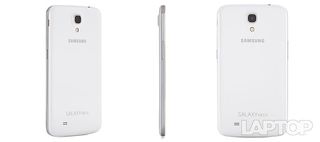
On its face, the Mega sports a 1.9-MP camera above the screen, and below that lies a physical home button. An 8-MP camera sits on the back toward the top, while the words Galaxy Mega adorn the bottom. A volume rocker sits almost at the center of the left edge, while a hold/power button lies on the right side. At the top of the phone is a 3.5mm audio jack, and on the bottom is a microUSB port.
MORE: Tablet Buyers' Guide 2013: 5 Questions to Ask Before You Buy
Measuring 6.6 x 3.5 x 0.3 inches and weighing 7 ounces, the Galaxy Mega dwarfs most smartphones, but it's certainly not the heaviest or largest in the phablet class. The HTC One Max (6.47 x 3.24 x 0.4 inches) and Nokia Lumia 1520 (6.40 x 3.36 x 0.34 inches) have smaller footprints -- owing to their smaller 5.9-inch and 6-inch screens, respectively -- but are thicker and weigh more. The HTC One Max weighs 7.65 ounces), and the Nokia Lumia 1520 weighs 7.26 ounces.
Display
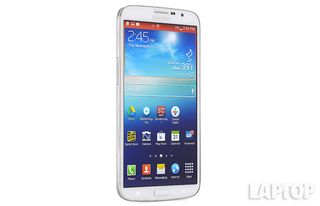
Click to EnlargeThe Mega's 6.3-inch screen is positively huge, but you'll have to make do with a resolution of 1280 x 720 pixels, as opposed to the full 1080p screen on the HTC One Max and Lumia 1520. The One Max is a pricier $149 on Sprint, while the 1520 costs $99 on AT&T.
When we watched a 1080p HD trailer for "Bounty Killer," we enjoyed rich colors and details so clear that we could see individual hairs in Matthew Marsden's stubble. Casual gaming and Web surfing were especially enjoyable, thanks to the ample real estate.
Outdoors, the Mega's bright screen outshone any glare from the sun. Viewing angles were plenty wide, and we saw no distortion in images when we tilted the phone up to 70 degrees.
Registering 398 lux on our light meter, the Mega's brightness is on a par with the average smartphone (399 lux), but dimmer than the HTC One Max (441 lux), the HTC One (459 lux) and the Samsung Galaxy S4 (446 lux).
Audio
Complementing the Mega's big display is the generous volume delivered by the device's innocuous-looking speaker. When we played "It's Time" by Imagine Dragons at full volume, the music enveloped a small bedroom. The song's rhythmic clapping intro sounded distinct and round, and lead singer Dan Reynolds' voice rang out loud and clear in the rousing chorus.
The Mega notched 83 dB on the LAPTOP Audio Test, which measures a tone played at full volume on the device from 13 inches. That's louder than the average smartphone (80 dB), the Verizon Samsung Galaxy S4 (81 dB), the Verizon Samsung Galaxy Note 2 (82 dB) and the Verizon HTC One (81 dB with Beats audio enhancement ).
Keyboard
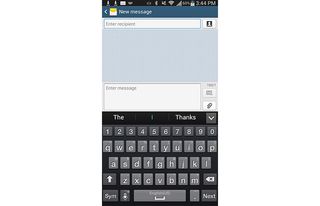
Click to EnlargeThe Mega's giant screen affords it plenty of space for a comfortably sized keyboard. You'll fly when typing with two thumbs, but the handset feels top-heavy when you're typing in portrait mode. While the device offers a smaller keyboard that you can reposition for easy single-handed use, we found it cumbersome to type on. The keys on the smaller keyboard were crowded, and farther-flung letters like Q and A were still hard to reach.
A device of this size almost begs to be used with a stylus, and while Samsung doesn't include its S Pen with the Mega, your finger works just fine. The Mega recognized our chicken scratch and accurately converted it to text.
Software and User Interface
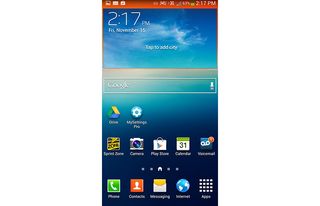
Click to EnlargeRunning Android 4.2.2 Jelly Bean with Samsung's TouchWiz interface, the Mega is missing some of the features found on its more advanced brothers (such as Air Gesture and Smart Screen), but still offers plenty of nifty TouchWiz customizations.
You can customize the Mega's lock screen with widgets and shortcuts, and personalize seven home screens however you like. Swipe down the notifications drawer to toggle a suite of settings, including connectivity options and Samsung-specific features such as Multi Window and S Beam.
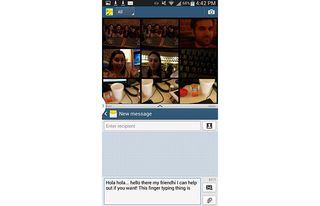
Click to EnlargeParticularly useful for a device this size is Samsung's Multi Window mode, which let us use multiple apps side by side. When Multi Window mode is enabled, a sidebar toggle shows up to let you launch one of 12 apps in a split screen. We loved checking movie times on Chrome while watching a trailer on the YouTube app at the same time. Best of all, we did all that without having to squint. You can launch up to two windows at a time on the Mega.
MORE: 12 Worst Android Annoyances and How to Fix Them
On the Mega, Samsung omitted such features as Smart Screen (including Smart Rotation, Stay Pause and Scroll) and Air Gesture, but you're not going to miss those tools. Air Gesture features -- such as Quick Glance, Air Jump, Air Browse, Air Move and Air Call Accept -- require a different IR sensor that isn't built into the Mega. You still get Air View, which lets you preview files or messages in your Email and Gallery apps by hovering a fingertip over the screen.
It's nice to see that the Mega takes advantage of its larger screen in some ways. For instance, in the Email app, you'll see your inbox on the left and message previews on the right. And in the Calendar app, the month view shows the calendar on the left and individual appointments on the right. We'd like to see Samsung go further and apply a similar treatment to the Settings app and other apps.
Performance
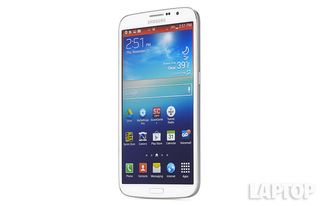
Click to EnlargePacking a 1.7-GHz dual-core Qualcomm MSM8930AB ARMv7 processor with 1GB of RAM, the Mega delivered mostly zippy performance. Switching screen orientations took about a second, and the camera snapped images in rapid succession with almost no pause between shots.
More demanding tasks took longer, though. Apps such as Browser, Camera and Messaging often took 2 to 3 seconds to start, while space shooting game "N.O.V.A. 3" took 17 seconds to load. That's slower than the average smartphone (15 seconds), the S4 (15 seconds), the HTC One Max (16 seconds) and the Verizon HTC One (16 seconds). It also took the device about 2 seconds to launch the same app, and another 2 seconds to return to the home screen.
On the Quadrant benchmark, which measures overall performance, the Mega's score of 8,565 was higher than the smartphone category average (7,312). However, the handset trailed the One Max's Snapdragon 600 (11,981), the Galaxy S4's Snapdragon 600 (11,308) and the One's Snapdragon 600 (12,378).
Scoring 4,550 on the graphics-focused 3DMark Ice Storm Unlimited, the Mega fell short of the average smartphone (9,540), the S4 (10,393), the One Max (10,984) and the Verizon HTC One (10,325).
It took the Mega 7 minutes and 39 seconds to transcode a 205MB 1080p video to 480p on VidTrim. That's faster than the average smartphone (8:21) but slower than the AT&T Note II (6:09), the One Max (7:33), the Verizon HTC One (7:33) and the S4 (7:25).
Apps
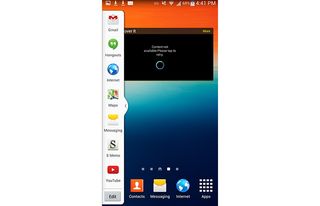
Click to EnlargeSamsung stuffed the Mega with a truckload of preloaded apps. The list includes S Browser, S Memo, S Translator, S Voice, Samsung Link, Samsung Hub, Samsung Apps, Group Play, ChatON, Photo Reader (through Google Photos), WatchON and Story Album. Third-party apps include TripAdvisor, Flipboard and Dropbox.
Sprint also packed 14 apps into the Mega, including the useful BaconReader (an app to view Reddit) and Sprint Zone, as well as Sprint ID, Sprint Connections Optimizer, Sprint TV, Sprint Music Plus, Scout, Lookout, Lumen Toolbar, 1Weather, CBS Sports, Next Radio and V8 Widget.
MORE: 25 Best Android Apps
The Mega also comes with standard apps such as Calculator, Camera, Clock, Play Books, Play Games, Play Magazines, Play Music and Play Store.
Camera
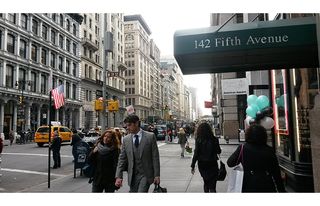
Click to EnlargeThe Galaxy Mega's 8-megapixel rear camera took sharp, vibrant pictures. Our shots of Manhattan streets were colorful and detailed, and yellow cabs and red buildings really popped. In low light, however, the Mega failed to deliver. Images of four friends in a restaurant were grainy and dull .
The rear camera shot beautiful 1080p video with vivid colors and clear details. Clips of New York streets showed yellow cabs and an American flag that stood out against gray buildings.
The Mega's 1.9-MP front camera snapped natural-looking images. The pink and blue of our shirt looked vibrant against the cream tones of the rest of the picture.
[sc:video id="dsZHE1cTr97gCjGklm9tLNnlUwyHrKFU" width="575" height="398"]
Camera Features
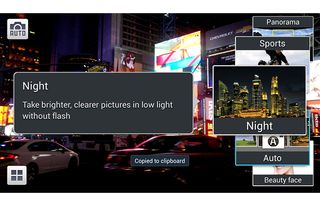
Click to EnlargeIt may not pack as many camera features as the S4, but the Mega offers plenty of tools to improve your shots. Samsung has omitted settings such as Drama Shot, Dual Camera and Eraser mode from the Mega but kept options such as Best Photo, Sound & Shot, HDR, Sports and Panorama.
You still get Best Face Mode, which merges the most flattering faces in a photo from a list of thumbnails into one image. Sound & Shot mode saves the background audio along with your picture, for a richer shot. We also appreciated how Night Mode significantly improved the color and clarity of our pictures of Times Square in the winter twilight.
Spark
Although its LTE footprint is small -- just 230 markets, compared with more than 500 for Verizon and 459 for AT&T -- Sprint is rolling out an enhanced LTE network called Sprint Spark. The service promises LTE speeds of up to 60 Mbps. According to Sprint, a 60-minute HD video will take only 2.5 minutes to download on Spark.
After we installed a software update to enable our Mega's tri-band Spark capability, we saw blistering LTE speeds. The update activated a spinning six-point sun icon in the phone's status bar, indicating Spark connectivity. In a downtown New York hotel room, with four bars of Spark reception, the Mega averaged 27.1 Mbps down and 8 Mbps up.
MORE: Sprint Spark vs. AT&T LTE: Which Network is Faster?
At two other testing sites, we saw consistently blazing speeds on the Mega. On the corner of 63rd Street and Lexington Avenue, the Mega delivered an average of 16.2 Mbps down and 13.24 Mbps up on the Speedtest app. A Spark-enabled HTC One Max delivered faster speeds at this spot, notching an average of 17.5 Mbps down and 17.8 Mbps up. At the same spot, a non-Spark Galaxy Note 3 showed average speeds of 8.46 Mbps down and 6.41 Mbps up.
A 200MB trailer downloaded in just 1 minute and 44 seconds, slightly faster than on the One Max (1:45). The same file took 4 minutes and 41 seconds to come through on the Note 3 over Sprint's regular 4G LTE network.
On the Mega, the NYTimes.com and picture-intensive Laptopmag.com took a respective average of 4.3 and 6.6 seconds to load. The One Max loaded NYTimes.com and Laptopmag.com in 3.2 and 6.4 seconds, respectively.
When we got to the corner of 56th and Lexington, the number of bars for Spark on the Mega fluctuated between two and five. At this location, the Mega recorded impressive average Speedtest scores of 39.7 Mbps down and 15.2 Mbps up. The One Max on Spark fared better on upload speeds (17.3 Mbps) but poorer on download speeds (35.9 Mbps).
We downloaded a 238MB trailer at this location. The Mega on Spark delivered the file in just 53 seconds, slightly faster than the One Max (53.55 seconds) and much speedier than the Note 3 (5 minutes and 23 seconds).
Battery Life and Call Quality
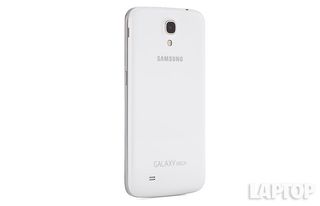
Click to EnlargeThe generous 3,200 mAh battery on the Mega lasted 7 hours and 13 minutes on the LAPTOP Battery Test, which involves continuous Web surfing over 4G LTE . However, this test was done in a location where we only received LTE, and not Spark service.
That's almost an hour longer than the average smartphone (6:35) and the S4 (5:49), even when the S4 was on Power Saving mode (6:05). The Mega's battery beat the HTC One's 5 minutes and 17 seconds, but not when the latter was on Power Saving mode (7:50). It also lost to the Note II (9:51).
MORE: 10 Smartphones with the Longest Battery Life
Once you get over that Zack Morris phone feeling, the Mega offers good voice quality. We made calls to Manhattan landlines and cellphones in New York and Chicago. Our friends were able to hear us clearly, even though we were surrounded by sounds of street traffic.
Plans and Pricing
You can get the Galaxy Mega for $99 with a two-year agreement on Sprint. The carrier offers unlimited talk, text and data for $110 monthly with its My All-In plan, or unlimited talk and text starting at $50 a month with optional data add-ons.
With Sprint's early-upgrade plan, called One Up, users can get unlimited talk, text and data at just $65 and a manageable handset fee of $19.59 a month. Over two years, that will run you $2,066. Up front, the Mega would set you back $469.
MORE: Samsung 2013 Rating: Best and Worst Smartphone Brands
Competing smartphones cost about the same or less. The HTC One costs $99 down with a two-year plan, while the S4 will set you back $149 (you can get it for $99 with a mail-in rebate) on the same plan. But if you want a phablet, the Mega is the cheapest on the market right now. The HTC One Max and the Galaxy Note II both cost $149 on Sprint.
Verdict

Click to EnlargeMade for the budget-conscious shopper looking for a tablet and phone in one device, the $99 Galaxy Mega packs plenty of features, speedy Spark LTE throughput, a large screen and a long-lasting battery. However, because this is a midtier device, you'll have to be willing to settle for a lower-res display than those found on other flagships (720p) and a slower dual-core CPU.
The HTC One Max offers a more stylish design, better quad-core performance and a higher-resolution display for just $50 more, but it's heavier and doesn't do as much as the Mega, software -wise, to take advantage of the extra screen real estate. If you're willing to splurge, the $249 Galaxy Note 3 on Sprint offers the best combination of size, performance and battery life of any phablet, but it doesn't support Sprint's faster Spark service.
Bottom line: If you're looking for a phablet for an affordable price, the $99 Galaxy Mega on Sprint offers a lot of device for your money.
Samsung Galaxy Mega (Sprint) Specs
| Alternate Carriers | AT&T |
| Bluetooth Type | Bluetooth 4.0 LE |
| Brand | Samsung |
| CPU | 1.7 GHz dual-core Qualcomm MSM8930AB ARMv7 |
| Camera Resolution | 8 MP |
| Carrier | Sprint |
| Company Website | http://www.samsung.com/latin_en/consumer/mobile-phones/mobile-phones/smartphone/GT-I9200ZKATTT |
| Data | EDGE/GPRS/HSPA+/LTE, HSUPA, HSDPA 21 Mbps |
| Display (main) | 6.3 inches, 1280 x 720 |
| Display Resolution | 1280x720 |
| Form Factor | Candybar Touchscreen |
| Front Camera Resolution | 1.9MP |
| Internal Memory | 16 GB |
| Memory Expansion Type | microSD Card |
| Networks | HSPA+, EDGE / GPRS (850 / 900 / 1.800 / 1.900 MHZ) |
| OS Family | Android |
| Operating System | Android 4.2 |
| Phone Display Size | 6.3 |
| Processor Family | Qualcomm MSM8930AB |
| RAM | 1GB |
| Size | 6.6 x 3.5 x 0.3 inches |
| Talk / Standby Time | Up to 22 hours talk time |
| Weight | 7 ounces |
| Wi-Fi | 802.11 a/b/g/n/ac |
